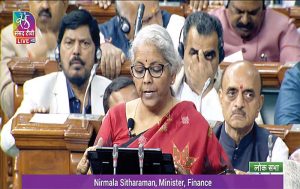The pre-election Union Budget 2023-24 turned out to be CapEx-intensive. Ashish Bhatia looks at the leeway for green mobility and infrastructure over the next fiscal.
The Union Budget 2023 turned out to be CapEx intensive despite being a pre-election year. At 3.3 per cent of the GDP, the capital investment outlay was raised for the third year in a row to rupees 10 lakh crore. The increase is pegged at 33 per cent. Finance Minister, Nirmala Sitharaman, in her fifth budget presented to the parliament, pointed at the 3x raise over 2019-20. Calling it the “first budget in Amrit Kaal” she set out to reflect an empowered and inclusive economy. Building on the foundation laid last year (with Union Budget 2022-23), she hailed the seven per cent growth rate as the highest among world economies. Admitting to the Covid-19 and war-induced slowdown, she put across her firm belief that the nation was on the right track. She spoke highly of India’s global profile due to several accomplishments under the BJP-led government and weaved the budget aimed at building a world-class infrastructure with a focus on green mobility and integrated transport.
Setting out to achieve climate-related goals the National Hydrogen Mission plan has the country aiming for a production of Five MMTA of hydrogen and bolster its energy independence agenda. The action plan for establishing a Green Hydrogen ecosystem and catalysing a systemic response to the opportunities and challenges of this sunrise sector is in line to achieve net zero emissions by 2070. Calling the budget “people-centric”, aimed at offering a better quality of life, and one offering a conducive environment for business, it circled back to progress on Sustainable Development Goals (SDGs).
The FM began the speech by stressing the need to promote and tap the large potential in the tourism sector that should rekindle hopes for the tours and operators ecosystem of the Covid-19 battered sector. To realise this potential, the government invoked the Public Private Partnership (PPP) model. To further the “Green Growth” agenda, the FM emphasised the need to pay due attention to ‘Green Fuel’, “Green Energy’, ‘Green Farming’ and ‘Green Mobility’ with ‘Green Infrastructure’. She called upon the need to reduce carbon intensity in each of the spheres, and urged the need to look at “inclusive development” right up to the last mile.
Farm mechanisation and farmer welfare
Under inclusive development, the need to put in place a digital infrastructure and establish farmer-centric solutions found mentioned. The agricultural economy of the nation finds itself with a big void if the farmer did not have better access to farm inputs, she implied. To address this, she announced an agri-fund to encourage startups in the sector. This would be made possible with better collaboration between the farmer, state and the government at the centre. The Union Budget 2023-24 earmarked an Rs.2000 crore outlay for horticulture, to begin with. With India leading the millet movement, linked to farmer welfare, the agriculture credit target was capped at Rs.20 lakh crore. Sugarcane farmers got a relief of Rs.10,000 crore. The budget set aside Rs.6000 crore for the fisheries sector and committed to setting up fishery and dairy cooperative societies over the next five years in uncovered regions. Admitting to upskilling being the need of the hour, FM announced last-mile welfare schemes in her budget too.
The multiplier effect of infrastructure
Admitting to infrastructure development has a multiplier effect on the economy, FM Sitharaman, hailed the growing private sector investments. The government announced an extension of the support to state governments for an additional year in a bid to spur investments in infrastructure. The outlay was capped at Rs.1.3 lakh crore. Citing the importance of public resources for the road, rail and infrastructure development, railways were granted Rs.2.40 lakh crore at its highest outlay ever. This is estimated to be 9x of the 2013-14 outlay. The budget had the government identifying 100 critical infra and transport projects with an Rs.75,000 crore outlay in comparison. Regional air connectivity was given a boost too with the announcement of new infrastructure.
FM Sitharaman encouraged states and cities to undertake urban planning in a bid to make them sustainable cities of tomorrow. This, the FM stressed, entails better urban land utilisation. Prioritising desludging, is an important move, with the budget committed to 100 per cent mechanisation being a strong focus area. To live up to its motto of ease of doing business, FM announced the reduction of 39,000 compliances to rid the businesses of the compliance burden often referred to. Three Centres of Excellence (CoE) will further be built in partnership with the industry to leverage Artificial Intelligence (AI) through ‘Make AI In India’ to ‘Make AI Work For India’. The state support extended to the govt. think tank Niti Aaayog would also continue to give it the desired effect. In a shift from Aadhaar, PAN was made the common business identifier. To leverage 5G, the budget committed to setting up 100 5G labs in engineering institutions for realising new business opportunities and employment.
Green growth
To reduce the nation’s dependence on fossil fuel imports and reach the maximum potential of the sunrise sector, energy transition was deemed crucial. The budget set aside Rs.35,000 cr as priority capital to accelerate the transition by the Ministry of Petroleum and Natural Gas. Rs 3,500 crore was set aside to offer Viability Gap Funding (VGF) for Battery Energy Storage Systems (BESS) with a total capacity of 4,000 MWh. The FM highlighted renewable energy evacuation as crucial to overcoming a big hurdle in the lack of infrastructure for renewable energy development. The government set aside Rs.19,700 crore for the National Hydrogen Mission.
On the scrappage policy mentioned in the budget 2021-22, the FM made provisions for allocation and support for states. The replacement of old state vehicles and ambulances would be prioritised. Under the Gobardhan scheme, 500 new waste-to-wealth plants were announced. A sum of Rs.10,000 cr to set up 200 Compressed Biogas plants was also set aside to boost the green growth vision plan. GIFT city gained Rs.10000 crore per year city urban infra fund. An Rs.9000 corpus fund was set up for MSME credit. The Budget, to further support green mobility, called for the need to avoid cascading of taxes and exemption of excise duty. The FM gave the green signal to customs duty extension on the import of capital goods and lithium-ion battery packs. It further announced a customs duty reduction on the ethanol blending programme. On compounded rubber, it was announced that circumvention on duty would be curbed to bring it to part with natural rubber.
To further ease the compliance burden, under direct taxes, the FM committed to maintaining continuity and further simplification. She hailed the MSMEs as the growth engines of the nation. Micro enterprises with a turnover of two crores and up to 50 lakhs crores received an enhancement on limits up to three crores and 75 lakhs crore where cash receipts are no more than five per cent. Acknowledging the contribution of startups, the FM deemed entrepreneurship as vital to the third largest ecosystem, globally and a growing economy and extended a 10-year tax holiday. In her concluding statement, the FM informed the house that states would be allowed a fiscal deficit of 3.35 per cent of GSDP. The overall fiscal deficit was pegged at 5.9 per cent of GDP with the government claiming to spend in tune with the macroeconomic developments. It has set a target to reach below 4.5 per cent by 2025-26 on the path of fiscal consolidation.
 Vinod Aggarwal, President, SIAM and MD & CEO, VECV Ltd.
Vinod Aggarwal, President, SIAM and MD & CEO, VECV Ltd.
A 33 per cent increase in capital outlay with an effective provision of Rs.13.7 lakh crore will spur growth in the economy resulting in a positive impact on the auto sector. The industry is fully aligned with the initiatives on sustainability and decarbonisation and increased focus on hydrogen, ethanol blending, biogas, EVs and battery storage. All in all, this is a growth-oriented budget with a positive impact on the auto sector.
 P B Balaji, Group CFO,
P B Balaji, Group CFO,
Tata Motors Ltd.
The well-rounded and pragmatic Union Budget 2023 provides further impetus to the auto industry. Overall, the confident, finely balanced budget will spur consumption, will crowd in investments without raising inflationary fears and build further confidence amongst global investors in India’s sustainable growth story and take rapid strides towards achieving ‘Amrit Kaal’.
 Dheeraj Hinduja, Executive Chairman, Ashok Leyland Ltd.
Dheeraj Hinduja, Executive Chairman, Ashok Leyland Ltd.
The budget emphasises comprehensive national infrastructure development and expands on the digitisation of the economy. The road transportation sector plays an important role in national development and would have an even more impactful role, going forward, in supporting the Government’s vision. This budget also echoes our sentiment and commitment to clean energy vehicle.
 Mahesh Babu, Chief Executive Officer, Switch Mobility Ltd.
Mahesh Babu, Chief Executive Officer, Switch Mobility Ltd.
The government’s focus on infrastructure with enhanced cap ex of Rs.2.7 lakh crore for roads and highways and the budgetary allocation for vehicle scrappage, will certainly accelerate the growth of the CV market in India. Meanwhile, in the EV sector, the government’s move to provide customs duty exemption for the import of specified capital goods and machinery required for the manufacture of lithium-ion cells for batteries is a welcome move, that will play a vital role in making local cell manufacturing cost competitive in the long run. Additionally, green growth is one of the top seven priorities, with an allocation of Rs.35,000 crore, which is a step in the right direction.
 Satyakam Arya, Managing Director & CEO, Daimler India Commercial Vehicles
Satyakam Arya, Managing Director & CEO, Daimler India Commercial Vehicles
Our overall view of the FY 2024 budget is that it is expansive and pragmatic. The budget clearly indicates a penchant for sustainable growth with the potential of aligning with long-term objectives. While the infrastructure push is a fiscal multiplier, it also gives the CV industry plenty of projects to look out for in the medium term. However, we were also expecting more on the National Logistics Policy, and its strategy which was drafted exceptionally and we were eager to see it get implemented or at least have an outlay. A more specific mention of the continuity of the Scrappage Policy would have given a direction to the industry, not just for preparing to replace phased-out vehicles with new ones but to encourage the proliferation of scrappage companies to expand their businesses. The FY 2023-24 Budget shows consistency but the near-term capital inflow is worth monitoring and improvising on in order to transform consistency into healthy momentum.”
and state governments will be replaced as part of the vehicle scrapping policy presents a significant opportunity for fleet modernisation. This budget also echoes our sentiment and commitment to clean energy vehicles for a cleaner and greener future, as part of a national mission to achieve the net zero carbon emission goal.
 Sunil Puri, Managing Director – India & SAARC Operations– CASE Construction Equipment
Sunil Puri, Managing Director – India & SAARC Operations– CASE Construction Equipment
The bolstering of infrastructure development is among the seven priority areas in the union budget’s proposal. With 50 new airports being targeted, Rs.2.7 lakh crore being allocated for road infrastructure and Rs.2.4 lakh crore for railways, the government is placing the right onus on infrastructure development, as it has in recent years. We are also enthused by the announcement of an urban infrastructure development fund and the opportunities presented for private investment in infrastructure through the newly established Infrastructure Finance Secretariat.
 Suresh KV, President & Regional Head, ZF India
Suresh KV, President & Regional Head, ZF India
This budget highlights significant positive initiatives for the automobile industry through a slew of announcements supporting state government and municipalities in scrapping pollution-causing vehicles. The scheme makes way for faster electric vehicle adoption and helps transition to cleaner mobility in the long run. The national green hydrogen mission will help the economy transition to low carbon intensity and reduce reliance on fossil fuel imports which would help guide the industry’s services toward smart logistics of the future. The increased outlay for infrastructure will also assist the transportation sector as a whole.
 Pratik Kamdar, Co-Founder, Neuron Energy
Pratik Kamdar, Co-Founder, Neuron Energy
The customs duty exemption on capital goods and machinery to manufacture li-ion will be a facilitator for the country to transition to sustainable and eco-friendly mobility. The exemption will have a domino effect on the overall sector with a substantial decrease in the overall cost of the finished products wherein the battery packs are likely to reduce by five per cent coupled with lower initial investments. Additionally, the vehicle scrapping policy will also be beneficial if the old vehicles are replaced by electric vehicles. This will further aid in the country’s vision of mass EV adoption by 2030.
 Jayadev Galla, Chairman & Managing Director, Amara Raja Batteries Pvt. Ltd.
Jayadev Galla, Chairman & Managing Director, Amara Raja Batteries Pvt. Ltd.
With a total outlay of Rs.35,000 crore for the energy transition segment, custom duty exemptions on the import of capital goods and machinery for lithium-ion batteries and the National Green Hydrogen Mission will provide a fillip to the EV and allied industries. The support through a viability gap funding to set up a battery storage capacity of 4,000 MWh will create a critical infrastructure that makes renewable energy storage a reality.
 Pankaj Sharma, Co-Founder & Director, Log9 Materials
Pankaj Sharma, Co-Founder & Director, Log9 Materials
The government’s decision to extend the concessional duty on lithium-ion cells for batteries for another year is welcoming as it would sustain the ongoing momentum within the Indian EV sector. Considering EV batteries account for ~ 60 per cent of the EV cost, this relaxation will make EVs more affordable and hence enhance the EV adoption rate.
 Pranav Goel, CEO & Co-Founder, Porter
Pranav Goel, CEO & Co-Founder, Porter
The investment plan for 100 critical transport infra projects including the capital outlay for railways will enhance the multimodal logistics ecosystem, aiding the sector to be more streamlined. We are elated with the move to expand the scope of Digilocker. With this, the KYC process will be simplified and the move to use a Permanent Account Number (PAN) as a common identifier for all digital systems of specified government agencies will encourage an efficient maintenance system. The tax benefits for the startup community will play a pivotal role in shaping the high growth sector.”
 Stefano Sanchini, Managing Director, Bridgestone India
Stefano Sanchini, Managing Director, Bridgestone India
The Government’s proposal to increase the capital expenditure outlay by 33 per cent is a welcome move as this will directly impact the logistics and mobility sectors. These sectors would also grow as they expand to serve the enhanced demand for goods generated by new infrastructure projects. The Finance Minister’s statement on replacing old government vehicles will increase the demand for new vehicles and we are committed to supporting the OEMs to meet this demand.




















